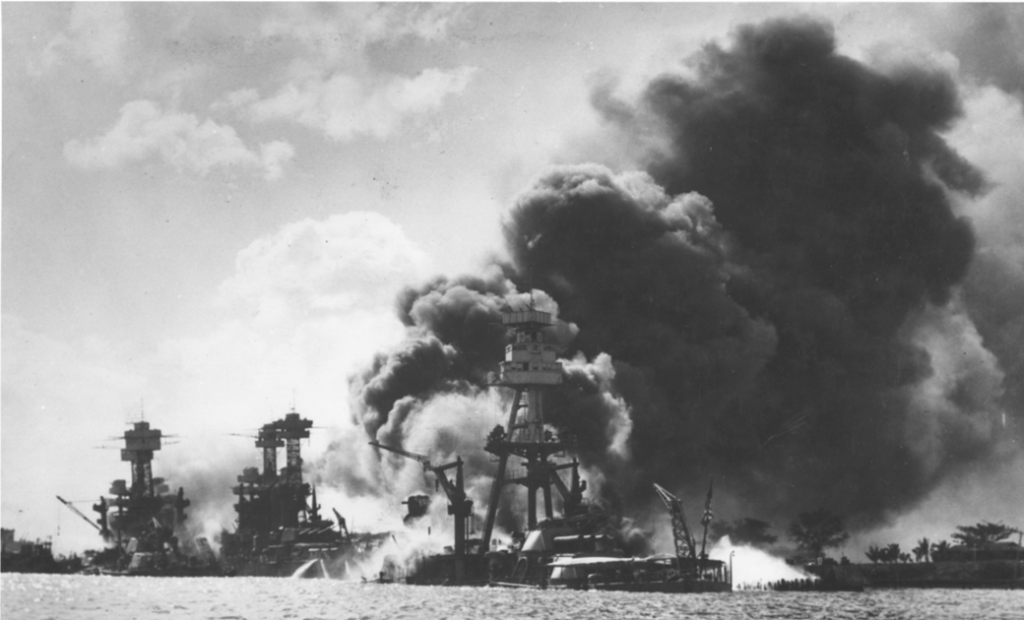
“Yesterday, December 7, 1941 – a date which will live in infamy – the United States of America was suddenly and deliberately attacked by naval and air forces of the Empire of Japan.”
These were the words spoken by President Franklin D. Roosevelt following the Japanese attack on the Pearl Harbor naval base near Honolulu, Hawaii. Just one hour after this speech, Congress would pass an official declaration of war on Japan, bringing the United States into WWII.
Although tensions had been rising between the U.S. and Japan for some time, the attack came completely as a surprise. Any attack from Japan was expected to happen in other areas of the South Pacific, which meant that the Pearl Harbor base was left largely undefended. Almost the entirety of the U.S.’s Pacific fleet and hundreds of aircraft were located at Pearl Harbor. The motive behind the plan was to destroy as many U.S. ships as possible, so that nothing could hinder Japan’s forces as they conquered the South Pacific.
The attack, which occurred just before 8 a.m. on December 7, 1941, resulted in the deaths of 2,403 civilians and service members. Additionally, 1,178 were injured, 188 aircraft were destroyed, and two U.S. Navy battleships, the USS Arizona and the USS Utah, permanently sank.
Continuing in his speech, Roosevelt said, “But always will our whole Nation remember the character of the onslaught against us. No matter how long it may take us to overcome this premeditated invasion, the American people in their righteous might will win through to absolute victory.
I believe that I interpret the will of the Congress and of the people when I assert that we will not only defend ourselves to the uttermost but will make it very certain that this form of treachery shall never again endanger us.”
Just three days later, Germany and Italy declared war on the United States. Congress then turned right around and declared war on Germany and Italy, bringing the U.S. solidly into WWII.
Decades later, on August 23, 1994, Congress would declare December 7th as National Pearl Harbor Remembrance Day. Flags are flown at half-mast and events are held throughout the country, including at the Pearl Harbor Memorial and Hawaii.
Pearl Harbor Remembrance Day is a prime example of what we hope to do at NVMM. Not only does Remembrance Day serve as a way to educate American citizens about what happened on December 7th, 1941, but it serves as a way to honor the 2,403 lives lost in the attack. Just as we strive to preserve the legacies of those are who served throughout the museum, Remembrance Day strives to preserve the legacies of those who lost their lives at Pearl Harbor through stories and memorials.
Fast Facts:
- Both the USS Utah and USS Arizona were declared National Historic Landmarks in 1989.
- The USS Arizona continues to leak oil to this day, with the black spots often called the “tears of the Arizona.”
- Cook Third Class Doris “Dorie” Miller, who served on the USS West Virgina, took over a 50-caliber Browning anti-aircraft machine gun, despite having little to no experience with the weapon. He managed to shoot down between four and six Japanese planes before being ordered to abandon ship. Miller later became the first African-American to receive the Navy Cross.
- Some former crewmembers of the USS Arizona have chosen the sunken ship as their final resting place. Following a full military funeral, the urn can be placed beneath one of the Arizona’s gun turrets.
- In March 1961, Elvis Presley, who had recently finished a two-year stint in the U.S. Army, performed a benefit concert at Pearl Harbor’s Block Arena and raised over $50,000 towards the building of the USS Arizona Memorial. This ended up being approximately 10% of the total cost.
- Numerous movies have been made about the events leading up to Pearl Harbor, the attack, and the U.S.’s subsequent involvement in WWII including Pearl Harbor (2001) and Midway (2019).



